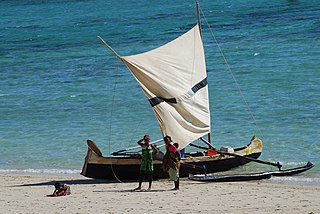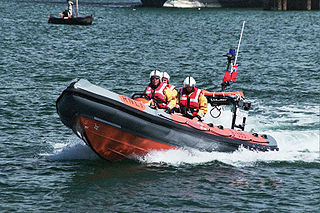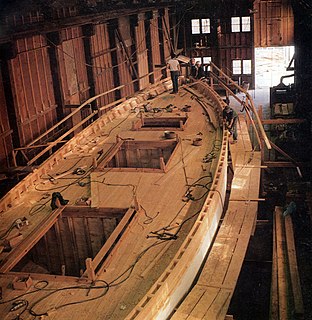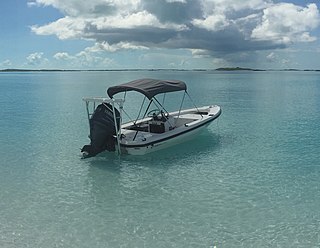
A hull is the watertight body of a ship, boat, or flying boat. The hull may open at the top, or it may be fully or partially covered with a deck. Atop the deck may be a deckhouse and other superstructures, such as a funnel, derrick, or mast. The line where the hull meets the water surface is called the waterline.

A kayak is a small, narrow watercraft which is typically propelled by means of a double-bladed paddle. The word kayak originates from the Greenlandic word qajaq.

A multihull is a ship or boat with more than one hull, whereas a vessel with a single hull is a monohull.

A dory is a small, shallow-draft boat, about 5 to 7 metres or 16 to 23 feet long. It is usually a lightweight boat with high sides, a flat bottom and sharp bows. It is easy to build because of its simple lines. For centuries, the dory has been used as a traditional fishing boat, both in coastal waters and in the open sea.

A canoe is a lightweight narrow water vessel, typically pointed at both ends and open on top, propelled by one or more seated or kneeling paddlers facing the direction of travel and using a single-bladed paddle.

A scow is a smaller type of barge. Some scows are rigged as sailing scows. In the 19th and early 20th centuries, scows carried cargo in coastal waters and inland waterways, having an advantage for navigating shallow water or small harbours. Scows were in common use in the American Great Lakes and other parts of the U.S., Canada, southern England, and New Zealand. In modern times their main purpose is for recreation and racing.

The koch was a special type of small one or two mast wooden sailing ships designed and used in Russia for transpolar voyages in ice conditions of the Arctic seas, popular among the Pomors.

A pirogue, also called a piragua or piraga, is any of various small boats, particularly dugouts and native canoes. The word is French and is derived from Spanish [piˈɾaɣwa], which comes from the Carib piraua.

A rigid inflatable boat (RIB), also rigid-hull inflatable boat or rigid-hulled inflatable boat (RHIB), is a lightweight but high-performance and high-capacity boat constructed with a rigid hull bottom joined to side-forming air tubes that are inflated with air to a high pressure so as to give the sides resilient rigidity along the boat's topsides. The design is stable, light, fast and seaworthy. The inflated collar acts as a life jacket, ensuring that the vessel retains its buoyancy, even if the boat is taking on water. The RIB is an evolutionary development of the inflatable boat with a rubberized fabric bottom that is stiffened with flat boards within the collar to form the deck or floor of the boat.

An inflatable boat is a lightweight boat constructed with its sides and bow made of flexible tubes containing pressurised gas. For smaller boats, the floor and hull is often flexible, while for boats longer than 3 metres (9.8 ft), the floor typically consists of three to five rigid plywood or aluminium sheets fixed between the tubes, but not joined rigidly together. Often the transom is rigid, providing a location and structure for mounting an outboard motor.

Boat building is the design and construction of boats and their systems. This includes at a minimum a hull, with propulsion, mechanical, navigation, safety and other systems as a craft requires.

An airboat is a flat-bottomed watercraft propelled by an aircraft-type propeller and powered by either an aircraft or automotive engine. They are commonly used for fishing, bowfishing, hunting, and ecotourism.

Sharpies are a type of hard chined sailboat with a flat bottom, extremely shallow draft, centreboards and straight, flaring sides. They are believed to have originated in the New Haven, Connecticut region of Long Island Sound, United States. They were traditional fishing boats used for oystering, and later appeared in other areas. With centerboards and shallow balanced rudders they are well suited to sailing in shallow tidal waters.

A punt is a flat-bottomed boat with a square-cut bow, designed for use in small rivers or other shallow water. Punting is boating in a punt. The punter generally propels the punt by pushing against the river bed with a pole. A punt should not be confused with a gondola, a shallow draft vessel that is structurally different, and which is propelled by an oar rather than a pole.
A chine in boat design is a sharp change in angle in the cross section of a hull. The chine typically arises from the use of sheet materials as the mode of construction.

A jon boat is a flat-bottomed boat constructed of aluminum, fiberglass, wood, or polyethelene with one, two, or three seats, usually bench type. They are suitable for fishing, hunting and cruising. The nearly flat hull of a jon boat tends to ride over the waves rather than cut through them as a V-hull might; this shallow draft – only a few inches – enables the jon boat to operate in very shallow water, but limits its use to calm waters. Jon boats typically have a transom onto which an outboard motor can be mounted. They are simple and easy to maintain, and inexpensive, though with many options to upgrade. Typical options may include live wells/bait wells, side or center consoles, factory installed decks and floors, electrical wiring, accessory pads/mountings, and casting and poling platforms.
The Norfolk Punt is a type of yacht, derived from the flat-bottomed gun punts that roamed the Broadland waters in the mid-to-late 19th century. However, at the turn of the 20th century, in order to get to and from the hunting grounds more quickly, the punters developed their highly unstable craft to carry a basic mast and sail for travelling with the wind. It is from these humble beginnings that one of the country's most exciting and powerful racing dinghy classes was born.

The Raid on Le Havre was a two-day naval bombardment of the French port of Le Havre early in July 1759 by Royal Navy forces under Rear-Admiral George Rodney during the Seven Years' War, which succeeded in its aim of destroying many of the invasion barges being gathered there for the planned French invasion of Great Britain.

Traditionally, many different kinds of boats have been used as fishing boats to catch fish in the sea, or on a lake or river. Even today, many traditional fishing boats are still in use. According to the United Nations Food and Agriculture Organization (FAO), at the end of 2004, the world fishing fleet consisted of about 4 million vessels, of which 2.7 million were undecked (open) boats. While nearly all decked vessels were mechanised, only one-third of the undecked fishing boats were powered, usually with outboard engines. The remaining 1.8 million boats were traditional craft of various types, operated by sail and oars.

Flats boats are a category of boat designed primarily for fishing in protected, shallow water areas often referred to as "flats" by anglers.



















